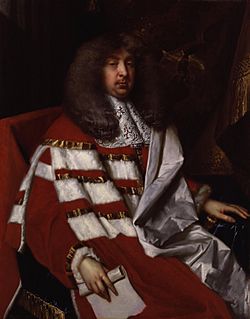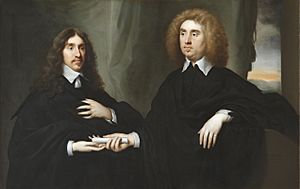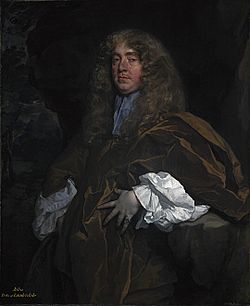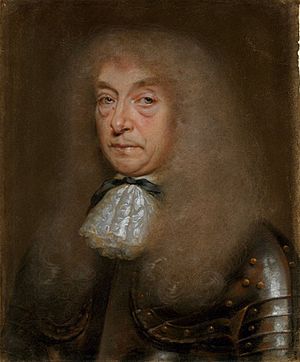John Maitland, 1st Duke of Lauderdale facts for kids
Quick facts for kids
The Duke of Lauderdale
|
|
|---|---|

John Maitland by Jacob Huysmans
|
|
| Lord High Commissioner | |
| In office 2 August 1669 – October 1680 |
|
| Monarch | Charles II |
| Preceded by | Earl of Rothes |
| Succeeded by | Duke of Albany |
| Secretary of State | |
| In office 19 January 1661 – October 1680 |
|
| Monarch | Charles II |
| Preceded by | William Kerr, 1st Earl of Lothian |
| Succeeded by | Earl of Middleton |
| Personal details | |
| Born | 24 May 1616 Lethington Castle, East Lothian, Scotland |
| Died | 24 August 1682 (aged 66) Tunbridge Wells, Kent, England |
| Resting place | St Mary's Collegiate Church |
| Spouses | Lady Anne Home Elizabeth, Countess of Dysart |
John Maitland was an important Scottish politician. He lived from 1616 to 1682. He became the 1st Duke of Lauderdale and was a key leader in a group called the Cabal Ministry. This group helped King Charles II rule.
Contents
Early Life and Family
John Maitland came from an old and important Scottish family. His father was John Maitland, who became the 1st Earl of Lauderdale. John was the oldest son who lived to adulthood. His family had roots in Berwickshire and East Lothian.
Supporting the Covenanters
John Maitland started his career supporting the Presbyterian church. This was a type of Protestant church in Scotland. He signed the Covenant, which was an agreement to defend the Presbyterian faith.
In 1643, he served as an elder in the Church of Scotland's General Assembly. He was also sent to England as a Commissioner for the Covenant. His job was to represent the Scottish Covenanters.
A Royal Advisor
In 1644, Maitland became a member of the Privy Council in both England and Scotland. This council advised the king. He tried to convince King Charles I to accept Presbyterianism.
In 1645, he advised King Charles I to reject certain proposals. In 1647, he was in London when the Scottish leaders decided to hand the king over to the Scots.
The English Civil War and Royal Support

After King Charles I surrendered, Maitland changed his mind. He decided to fully support the king's cause. He met with the king several times. He worked on plans to bring the king back to power.
Maitland offered Scottish help if the king would agree to establish Presbyterianism for three years. The king also promised to include Scottish nobles in English government. He also said he would visit Scotland often.
In 1648, Maitland returned to Scotland. He joined forces with English royalists. Their defeat at the Battle of Preston delayed Prince Charles's arrival. However, Maitland met with Prince Charles and gained his trust.
He convinced Prince Charles to go to Scotland in 1650. Maitland joined him on an expedition into England. He was captured after the Battle of Worcester in 1651.
Time in Prison

Maitland remained in prison from 1651 until March 1660. His lands were taken by Oliver Cromwell, the Lord Protector. Luckily for him, these lands were returned when the king came back to power.
The King's Return and New Role
Just before King Charles II returned to power in May 1660, Maitland joined him in the Netherlands. Despite some opposition, he was made Secretary of State for Scotland.
From this time, he stayed close to the king. He lived at Whitehall Palace and was always part of the king's discussions. He was very clever and determined. He managed to keep his position against many rivals.
Maitland was a very learned and intelligent man. He was also very firm in carrying out the king's orders. He helped restore the king's power in Scotland. He took control of the Scottish government. He also took strong actions against the Covenanters.
By 1669, he could proudly say that "the king is now master here in all causes and over all persons." This meant the king had full control in Scotland.
The Cabal Ministry and More Power
Maitland was a member of the Cabal Ministry. This was a group of five important advisors to King Charles II. He mostly focused on Scottish affairs. He supported King Charles II in his dealings with King Louis XIV of France.
On May 2, 1672, he was given the title of Duke of Lauderdale and Earl of March. On June 3, he became a Knight of the Garter. This was a very high honor.
In 1673, he became a Lord Commissioner of the Admiralty. He visited Scotland to deal with religious dissenters. He also tried to raise money for a war. Some people in the English Parliament tried to remove him from power. However, King Charles II and James, Duke of York, always supported him.
On June 25, 1674, he was also made Earl of Guilford and Baron Petersham in England. His harsh methods did not stop the religious meetings in Scotland. In 1677, he brought in Highlanders to control the western parts of the country.
Many Scottish nobles went to London to complain. They joined with English politicians. This forced King Charles to order the Highlanders to leave. In 1678, another attempt to remove Maitland failed by just one vote in Parliament.
He continued to be powerful almost until the end. He visited Scotland and made sure the king got the money he wanted. Another attempt to remove him in England was stopped when Parliament was dissolved. A final attack on him by Scottish and English groups also failed. In June 1679, the last Covenanter uprising was put down at the Battle of Bothwell Brig.
Later Years and Retirement

In early 1680, Maitland's health began to fail. He had a stroke or heart attack. Because of this, he resigned from his powerful positions in October 1680. He died on August 24, 1682.
Family Life
Maitland's first wife was Lady Anne Home. They had one daughter named Mary. Mary married John Hay, 2nd Marquess of Tweeddale.
After his first wife died in 1672, he married Elizabeth, Countess of Dysart. She was a widow with children from her first marriage. One of her children was General Thomas Tollemache.
John Maitland did not have any sons. So, when he died, his titles of Duke and his English titles ended. However, his brother, Charles Maitland, became the 3rd Earl of Lauderdale.
Images for kids
-
The Maitland tomb, St Mary's Church, Haddington
See also



